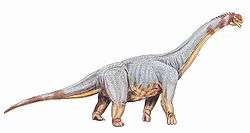Paralititan
| Paralititan Temporal range: Late Cretaceous, 95 Ma | |
|---|---|
 | |
| Life restoration | |
| Scientific classification | |
| Kingdom: | Animalia |
| Phylum: | Chordata |
| Class: | Reptilia |
| Clade: | Dinosauria |
| Order: | Saurischia |
| Suborder: | †Sauropodomorpha |
| Clade: | †Neosauropoda |
| Clade: | †Macronaria |
| Clade: | †Titanosauria |
| Genus: | †Paralititan Smith et al., 2001 |
| Type species | |
| †Paralititan stromeri Smith et al., 2001 (type) | |
Paralititan (meaning "tidal giant"[1]) was a giant titanosaurian sauropod dinosaur genus discovered in coastal deposits in the Upper Cretaceous Bahariya Formation of Egypt. It lived between 98 and 93 million years ago.[2] It was called by one science journalist "what appears to have been the second largest known creature ever to walk on Earth."[3]
Etymology
"Paralitptan stromeri"[4] means "Stromer's tidal (Greek para + halos "near sea") titan" or "Stromer's tidal giant". The name was coined by Kenneth Lacovara.[5] and published by Joshua B. Smith, Matthew C. Lamanna, Kenneth J. Lacovara, Peter Dodson, Jennifer R. Smith, Jason C. Poole, Robert Giegengack and Yousri Attia in 2001 to honor Ernst Stromer von Reichenbach, a German paleontologist and geologist who found dinosaurs in this area in the early 1900s.[1]
Description
The fossil represents the first ancient tetrapod reported from the Bahariya Formation since 1935. Its 1.69 meter (5.54 ft) long humerus is longer than that of any known Cretaceous sauropod.
Little of Paralititan is known, so its exact size is difficult to estimate. However, the limited material suggests that it is one of the most massive dinosaurs ever discovered, with an estimated weight of 59 t (65 short tons).[6] Using Saltasaurus as a guide, Carpenter estimated its length at around 26 m (85 ft).[7] Scott Hartman estimates an animal that is massive, but still smaller than the biggest titanosaurs such as Puertasaurus, Alamosaurus, and Argentinosaurus.[8] Dreadnoughtus is also more massive at 59.3 t (65 short tons).[9] Like other titanosaurs, it had a wide-gauge stance and may have possessed osteoderms for defense. The Paralititan type specimen appears to have been scavenged by a meat-eater. It is also possible that Paralititan was hunted by large predatory dinosaurs such as, Bahariasaurus, Carcharodontosaurus, and Spinosaurus, though this would only be possible if the mentioned predators were able to hunt in groups of at least several individuals.
Ecology
The autochthonous, scavenged skeleton was preserved in tidal flat deposits containing fossil mangrove vegetation. The mangrove ecosystem it inhabited was situated along the southern shore of the Tethys Sea. Paralititan is the first dinosaur demonstrated to have inhabited a mangrove biome.[1] It lived at approximately the same time as giant predators Carcharodontosaurus, Spinosaurus, and the sauropod Aegyptosaurus.
It was a ground-dwelling herbivore.[4]
In popular culture
Paralatitan was featured in Monsters Resurrected and two episodes of Planet Dinosaur.
The discovery of Paralititan is chronicled in the 2002 documentary The Lost Dinosaurs of Egypt, narrated by Matthew McConaughey, and in the companion book The Lost Dinosaurs of Egypt: The Astonishing and Unlikely True Story of One of the Twentieth Century's Greatest Paleontological Discoveries.[5]
References
- 1 2 3 Smith, Joshua B.; Lamanna, M.C.; Lacovara, K.J.; Dodson, P.; Smith, J.R.; Poole, J.C.; Giegengack, R.; Attia, Y. (2001). "A Giant sauropod dinosaur from an Upper Cretaceous mangrove deposit in Egypt". Science. 292 (5522): 1704–1706. doi:10.1126/science.1060561. PMID 11387472.
- ↑ Naish, Darren (2012). Planet Dinosaur : The Next Generation of Killer Giants. Firefly Books. p. 47. ISBN 978-1-77085-049-1.
- ↑ Roach, John (May 31, 2001). "'Tidal Giant' Roamed Coastal Swamps of Ancient Africa". National Geographic News. Washington, D.C.: National Geographic Society. Retrieved December 31, 2012.
- 1 2 "Paralititan Stromeri". Paleobiology Database. Retrieved December 31, 2012.
- 1 2 Nothdurft, William, et al., 2002, The Lost Dinosaurs of Egypt: The Astonishing and Unlikely True Story of One of the Twentieth Century's Greatest Paleontological Discoveries, Random House, 272 pp.
- ↑ Burness, G.P. and Flannery, T. (2001). "Dinosaurs, Dragonslayer, and Dwarfs: The Evolution of Maximal Body Size." Proceedings of the National Academy of Sciences, 98(25): 14518-14523.
- ↑ Carpenter, K. (2006). "Biggest of the Big: a Critical Re-evaluation of the Mega-sauropod Amphicoelias fragillimus." In Foster, J.R. and Lucas, S.G., eds., 2006, Paleontology and Geology of the Upper Jurassic Morrison Formation. New Mexico Museum of Natural History and Science Bulletin, vol. 36: pp. 131-138.
- ↑ http://www.skeletaldrawing.com/home/2013/06/the-biggest-of-big.html?rq
- ↑ "Scientific Reports".